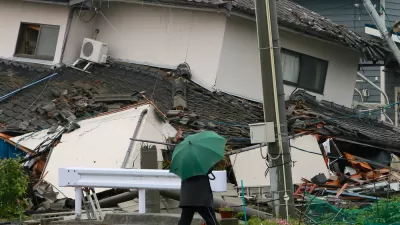Buildings constructed of unreinforced masonry get much if not most of the media's attention on seismic safety, but so-called 'soft story' wood buildings, often with garages on the ground floor, compose the greatest numbers of vulnerable buildings.
The August 24, 6.0 earthquake centered in Napa, Calif. may have caused $1 billion worth of damage and may also shake up state and city lawmakers to do more to reinforce vulnerable buildings. We look at both both unreinforced masonry and soft story buildings from a Bay Area perspective. Only one type has state law addressing retrofit.
"Although a 1986 state law mandates that local government identify unreinforced-masonry buildings, what the cities do about the problem is up to them. Some have mandatory compliance rules, while some make them voluntary," write Carla Marinucci, John Coté and J.K. Dineen of the San Francisco Chronicle.
As a result, safety is "still a bit of a piecemeal" from city to city, Hutchings Mieler said. "Local governments approach it all very differently - and even in the Bay Area, we have very different standards, city to city and county to county.
Contrast San Francisco's mandatory approach with Oakland's voluntary one.
- San Francisco has pursued legal action against some property owners over their failure to comply with the city's law, which was passed in 1992. Only a handful of buildings are still out of compliance, the city says.
- Oakland still has 80 to 90 unreinforced masonry buildings, said Deborah Sandercock, a city building official. Progress has been minimal in recent years because the city eliminated the building department's seismic safety division during the economic crisis, she said.
However, there is no legal requirement to reinforce "the thousands of structures [in Bay Area cities] known as soft-story buildings. In San Francisco alone, there are more than 4,000 of these multistory, wood-frame buildings with a garage, large windows or similar opening on the ground floor," write Marinucci, Coté and Dineen.
Until last year, only about 50 San Francisco property owners retrofitted their buildings, enticed by "a break on planning fees and expedited permitting," they note. Supervisors passed legislation last year to require reinforcement "over the next four to seven years." However, it only covers "wood-frame soft-story buildings built before 1978 that are at least three stories high and contain five or more dwelling units," they add.
Reinforcing consists of "installing walls below the floor at risk. The new walls resist being moved sideways by a quake," writes Alejandro Lazo of The Wall Street Journal (posted here).
For retrofitting historic buildings, state lawmakers introduced legislation "that would give property owners a 20 percent tax credit to help defray the cost. AB 1999 would end California's status as one of 15 states that do not offer credits for restoring historic structures," they add. The bill is in the Assembly awaiting concurrence with Senate amendments.
FULL STORY: Napa earthquake exposes dangers found in homes, shops, churches

Maui's Vacation Rental Debate Turns Ugly
Verbal attacks, misinformation campaigns and fistfights plague a high-stakes debate to convert thousands of vacation rentals into long-term housing.

Planetizen Federal Action Tracker
A weekly monitor of how Trump’s orders and actions are impacting planners and planning in America.

San Francisco Suspends Traffic Calming Amidst Record Deaths
Citing “a challenging fiscal landscape,” the city will cease the program on the heels of 42 traffic deaths, including 24 pedestrians.

Defunct Pittsburgh Power Plant to Become Residential Tower
A decommissioned steam heat plant will be redeveloped into almost 100 affordable housing units.

Trump Prompts Restructuring of Transportation Research Board in “Unprecedented Overreach”
The TRB has eliminated more than half of its committees including those focused on climate, equity, and cities.

Amtrak Rolls Out New Orleans to Alabama “Mardi Gras” Train
The new service will operate morning and evening departures between Mobile and New Orleans.
Urban Design for Planners 1: Software Tools
This six-course series explores essential urban design concepts using open source software and equips planners with the tools they need to participate fully in the urban design process.
Planning for Universal Design
Learn the tools for implementing Universal Design in planning regulations.
Heyer Gruel & Associates PA
JM Goldson LLC
Custer County Colorado
City of Camden Redevelopment Agency
City of Astoria
Transportation Research & Education Center (TREC) at Portland State University
Jefferson Parish Government
Camden Redevelopment Agency
City of Claremont




























